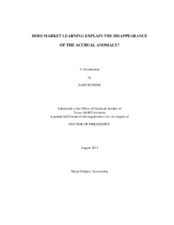| dc.description.abstract | This study investigates whether market learning explains the absence of the accrual anomaly in recent years by examining three conditions associated with the presence of the anomaly in prior research: (i) a differential relation between future earnings and cash flows versus accruals, (ii) incorrect weighting of cash flows and accruals by investors when predicting earnings, and (iii) association of earnings forecast errors with returns.
All of these conditions are widely documented in the anomaly period. In the no-anomaly period, I continue to find a differential relation of cash flows and accruals with future earnings. However, investors appear to correctly weight accruals and cash flows in their earnings predictions implicit in beginning-of-year security prices, consistent with learning. This study also investigates whether improvements in analyst forecasts contribute to investor learning and the absence of the anomaly. The association between analyst optimism and accruals is weaker in the no-anomaly period, but is still statistically significant. Furthermore, the anomaly ended simultaneously for firms followed by analysts and for non-followed firms, suggesting that improvements in analyst forecasts alone cannot account for improved market efficiency with respect to accruals. The results suggest that the anomaly was similar for firms held by institutional investors and for firms with no institutional holdings before the discovery of the anomaly while the anomaly ended sooner for held firms than for non-held firms after the discovery of the anomaly, consistent with the conjecture that arbitrage by institutional investors reduce the anomaly. Overall, the findings are consistent with market learning and suggest that improvement in investors' interpretation of accruals after the discovery of the anomaly explains the end of the anomaly. This improvement in investor learning is not due to changes in analysts' forecasting behavior, however. | en |


